Side effects of clindamycin hydrochloride injection?
summary
Clindamycin hydrochloride injection is suitable for moderate and severe infections caused by Streptococcus, Staphylococcus and anaerobic bacteria (including Bacteroides fragilis, Clostridium perfringens, actinomycetes, etc.), such as aspiration pneumonia, empyema, lung abscess, osteomyelitis, abdominal infection, pelvic infection and septicemia. Side effects of clindamycin hydrochloride injection? Next, I'd like to share my views with you.
Side effects of clindamycin hydrochloride injection?
Gastrointestinal reactions: common nausea, vomiting, abdominal pain, diarrhea, etc; Severe cases include abdominal colic, abdominal tenderness, severe diarrhea (watery or purulent), accompanied by fever, abnormal thirst and fatigue (pseudomembranous enteritis). Diarrhea, enteritis and pseudomembranous enteritis can occur at the beginning of the treatment, or a few weeks after discontinuation.
Blood system: leucopenia, neutropenia, eosinophilia and thrombocytopenia may occur occasionally; Aplastic anemia is rare. Abnormal liver and kidney functions, such as elevated serum aminotransferase, jaundice, etc.
Allergic reactions: rash, itching, occasionally urticaria, vascular edema and serological reaction, rare exfoliative dermatitis, bullous dermatitis, erythema multiforme and Steven Johnson syndrome.
matters needing attention
During the course of medication, close attention should be paid to the frequency of defecation. If the frequency of defecation increases, attention should be paid to the possibility of pseudomembranous enteritis. The drug should be stopped in time and appropriate treatment should be taken; If the above treatment is ineffective, metronidazole should be taken orally 250-500mg, three times a day. If recurrence occurs, metronidazole can be taken orally again. If still ineffective, vancomycin (or norvancomycin) can be taken orally 125-500mg, once every 6 hours, for 5-10 days.








